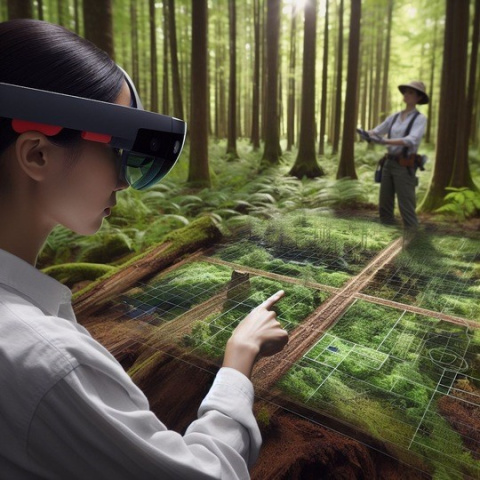Transparent Forests through Augmented Reality: XR Future Forest Lab launches at the University of Freiburg
The Faculty of Environment and Natural Resources (UNR) at the University of Freiburg is currently launching the “XR Future Forest Lab” project, which will develop innovative virtual reality (VR), augmented reality (AR) and mixed reality (MR) applications for research and teaching in the forest sciences. Starting 2024, the lab will be set up in stages and integrated into research and teaching at the UNR. This will give researchers and students pioneering opportunities to visualise forestry and environmental science data and simulate changes in forests. The laboratory will also be open to external partners and interested parties. The development of the XR Future Forest Lab is funded by the Eva Mayr-Stihl Foundation.
Digital twins of real forests
In the XR Future Forest Lab, real forest stocks can be captured as a digital twin, i.e. as a spatial and temporal representation of reality in the computer. Forest growth, forest management processes and the effects of environmental changes can then be simulated on the digital twin. When creating the digital twins, the XR Future Forest Lab draws on the extensive data sets on forests that are already available at the UNR. In addition, the researchers will develop and test new methods of digitising, standardising and modelling forest stands using the 127-hectare Mathislewald forest, which has served as a research and educational forest at the UNR for decades, as an example. “Digital data on forest stocks has been collected for a long time, but with the XR Future Forest Lab we want to intensify digitalisation and create a truly ‘transparent’ forest,” explains Prof. Dr Thomas Purfürst, Chair of Forest Operations and spokesperson for the XR Future Forest Lab’s expert management team.
Simulating natural changes and human intervention
The XR Future Forest Lab will enable digital forest data to be visualised and experienced with the help of VR, AR and MR technologies. "This combination of VR, AR and MR in forest science and forestry practice has never been seen before. Not only can we create virtual forests, but we can also superimpose information on reality and simulate natural changes or human intervention,” explains Prof. Dr Thomas Seifert, Chair of Forest Growth and Dendroecology and member of the expert management team. In addition to research, this also opens up new opportunities for teaching, emphasises Seifert. “Prospective foresters can use the XR technology to try things out on site in Mathislewald, for example, and experience digitally how specific measures, such as the removal of trees, will affect the forest.” Perceptions of developments in the forest over time are also made easier, as “changes that would otherwise take place very slowly can be visualised as if in fast forward,” adds Prof. Dr Teja Kattenborn, Professor of Sensor-Based Geoinformatics and member of the expert management team.
Funding through the Eva Mayr-Stihl Foundation
The Eva Mayr-Stihl Foundation is funding the establishment of the XR Future Forest Lab with 1.5 million euros until 2028. Michael von Winning, Chairman of the Foundation, explains the objectives. “We are facing an urgent problem. In view of our current climate challenges, it is important to understand in depth what effects forestry measures will have in forests, even over a long period of time. The project also strengthens Freiburg’s forest sciences because different disciplines work together and benefit from the results. We hope to gain timely insights for the design of the forest of the future.”
Contact:
Office of University and Science Communications
University of Freiburg
Tel.: 0761/203-4302
e-mail: kommunikation@zv.uni-freiburg.de
